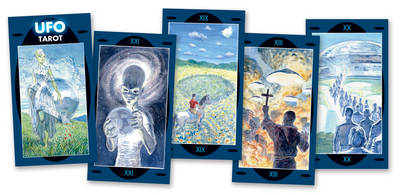

Edward Ka-Spel’s brilliance with The Legendary Pink Dots is to introduce us to isolated characters and then immerse us in their world-view through expansive and mysterious soundscapes. He begins with the most restricted, infinitesimal point of consciousness and then slowly expands it outward towards a state of ‘cosmic consciousness’ (to use the phrase of 1960s psychonauts). Musically, he often follows this template of expansion, with simple melody lines repeating and layering in increased complexity of texture. Much of the LPD’s music is an undertaking to help the listener (and perhaps composer) escape his/her own head. Lyrical phrases, musical motifs, album titles and themes recur across decades, but tonal shifts between albums are slow and subtle. Hopefully, The Legendary Dots Project, like the Residents and Sparks projects before, will provide the keen reader and listener with a giddy entry-point into the Legendary Pink Dots’ musical world. Fulfil the prophecy!
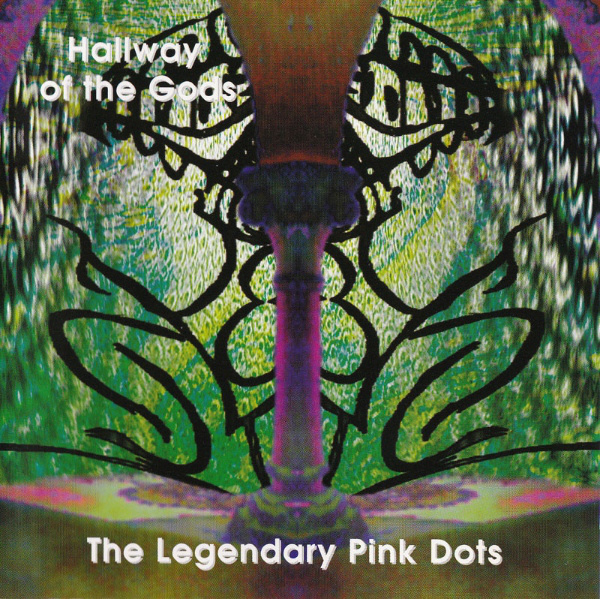
Hallway of the Gods (1997)
Tom: The astonishing Dots LP Hallway of the Gods was apparently released on 11 August 1997, Spotify says! I was currently enjoying a summer holiday from my comprehensive schooling, which had reached 60 per-cent of its duration.
I was getting deeper into music exponentially by the year from about 1995 on. Albums I bought include fairly incurable calls like Morrissey’s Maladjusted, U2’s Pop, Geneva’s Further and Sleeper’s final album Pleased to Meet You – on cassette! I would, rather later, get into greater 1997 long-players by Carl Craig, Billy MacKenzie, Labradford, Alpha, Autour de Lucie, Lida Husik and Stars of the Lid. I did however buy new records by Sizzla, Robert Wyatt, Prefab Sprout, The Fall and The Sundays that I would swear by to this day. I have also recorded my own cover version of James’s ‘Lost A Friend’… As you do!
Who couldn’t but admire Kenickie? Whose At The Club album was released in May 1997, a few weeks after a false dawn of political hope in Britain. They just couldn’t be ignored, especially growing up in those trash-glam pop outlaws’ very own city! I was kind of intimidated by them, of course; what kind of bookish 14 year-old male wouldn’t be?! Similarly, there were the first pop songs from the All Saints. I think that, even when getting into my cynical indie mind-set around this time, I simply couldn’t deny the glorious ‘Never Ever’. Far, far better all these ace women than the dulling Oasis, at this point releasing the bloated farrago Be Here Now ten days after Hallway of the Gods. Sadly, we know which shifted more units! I far preferred the other hegemonic popular LP of the year, Radiohead’s OK Computer, though while great as this was and is, its influence on other music hasn’t necessarily been good.
The Dots’ 1997 album actually seems to be in somewhat askew conversation with OK Computer, though is more mythically grandiose and ecological than Yorke and company’s sophisticated vision of a tortured technological dystopia. My review of this in-all-sense fantastic release is numbered according to the track listing.
- A tolling submerged well of bells beckons us into ‘On High‘. There are de-centred, de-centring, hazy synths. “That’s Greenland down below…” and an ecological Shakespearian noun phrase “This fragile globe“. “Got to pay this earth your mute respect because you never learned to love it…” Ka-Spel evokes the planet striking back, in its way, beyond any human sense of morality. The central repeated synth motif is circled by a saxophone. We hear higher synth notes. “I sense the train of hot hyenas, they’re licking at your heels.” “Hungry hawks. No sanctuary…” Ka-Spel seems to speak of the loss of a religious language which might be one of the few ways of achieving the necessary unity to save the planet. “And everyone… Is crazy…” The planet doesn’t care about you or provide for you if you don’t care for it.
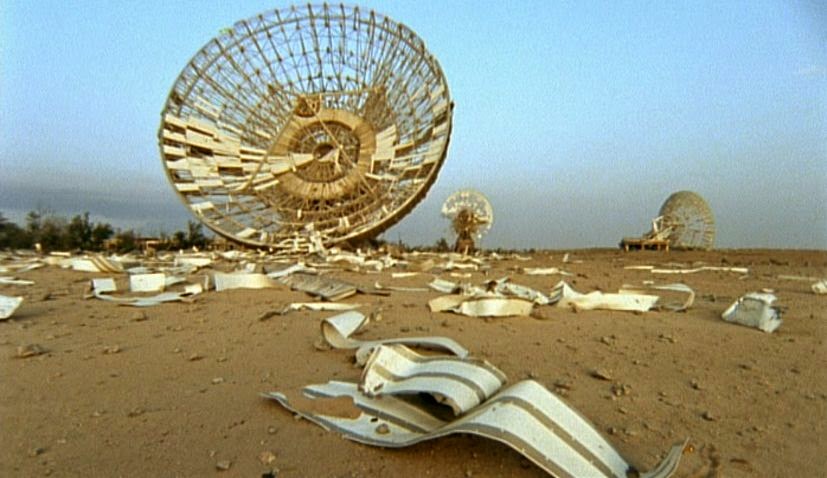
Human detritus in the desert in Werner Herzog’s Fata Morgana (1971) - This dissolves into hyper video game bleeps as we enter ‘Mekkanikk‘. We’re beckoned in by an archetypal, slow LPD minor key tune and unique (sibilant or other) word play. There is distant, quiet synth, like some stilled ghost of Bollywood or early 1980s jazz-funk. “Will you lubricate me with your precious soil?” Tremendous stuff, very brief; utterly concise.
- ‘Sterre‘ presents steady guitar, having a hazier, psychedelic Americana or even folk-rock feel. “Now here is a little, guiding finger.” It breaks down into guitars doing four clock tolls. Then one of the hopeful sounding LPD tunes RETURNS. “She is so beautiful tonight!” Wow. This feels very hard won, as a delightful low horn pattern enters, carving out sedate bonhomie. Ultimately upbeat accessible Dots? You bet cha!
- ‘Spike‘ has a more distended, electronic feel with loops. “Catching souls and drilling holes”. “Nature feels like Jesus till that sword gets driven…” As with track 1, this betokens the promise of New Testament Christianity betrayed, here in a specifically penal location. The narrator’s “desperate friend” had tried to climb a wall, presumably to escape, but in vain, as “they” sprayed it. He is dead. We have microcosmic entrapment here to complement the environmental disaster in ‘On High’.
“Oh you fucking fool, you left us carrying your useless pain and now we’re TRAPPED HERE TILL WE DIE!”
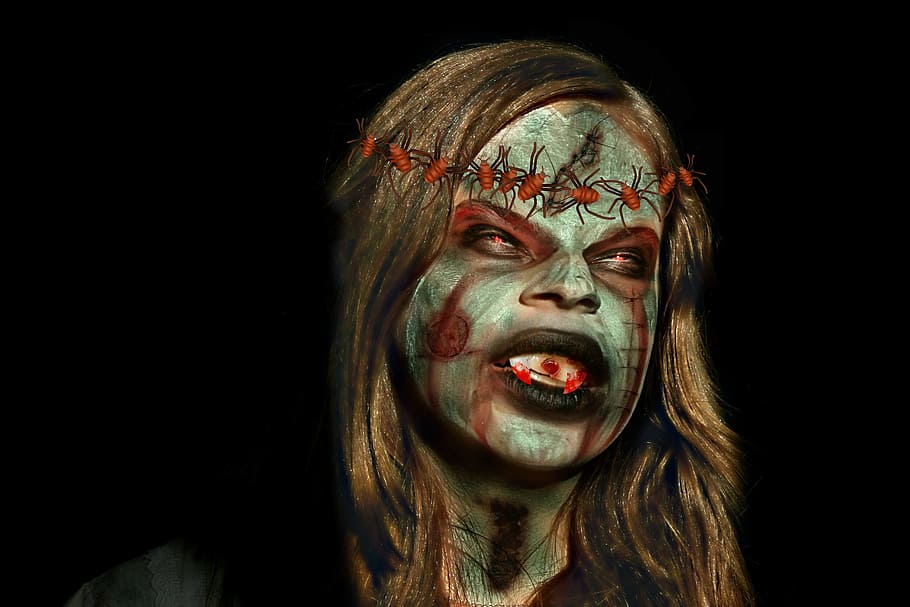
Ka-Spel unspools a scenario of imminent physical danger blended with awareness of doomed long-term entrapment. Enter: a new drum part and scorching guitars and swirling synths, and we are actually, suddenly, in Neu! Land: the LPDs entering fertile 1970s German progressive terrain. And it is tremendous. Great, great stuff so far, this LP!
- ‘All Sides‘ is cyclical, querying, eyebrow-arched. A laggard drum kit kicks in, as the narrator “stands here like a sheet”, having died. Wraith-like, indistinct Goth, this track fails to entice me quite so much as most do on Hallway of the Gods.
- However, ‘Harvest Babies‘ emphatically steps back up a gear with its lovely, sedate melody layered on top of a skittering, brisk rhythm. There’s a compelling, sustained note stretching out for acres of time from what sounds like a female Opera singer. Ka-Spel croak-croons: “Take me as I am. Take us as we are.” The bass is subtle, languid and even at moments suggests jazz. “Take us all…” A coiled lead guitar sounds, with barely subdued fieriness, meshing with organ in what is a satisfying ending which shifts towards space rock.
- ‘Lucifer Landed‘ in title suggests Current 93 but the guitar-led chords and vocals here sound uncannily like Robyn Hitchcock. The solo-guitar opening is even Richard Thompson-esque in its elegant simplicity. Satanic instructions, falling and making amends with “Holy Mary”s. There is a musing lull wherein an ornate horn enters. Then, a resplendent, off-centre synth string section with jaunty-yet-grandiose rising and falling six-note patterns takes us skywards. Such delightful stuff! In many ways, a good track to use to introduce anyone well versed in 1960s music to the Dots.
- ‘The Hanged Man‘ is shaggy dog psychedelia, straight-ahead Americana veering strange. “Angels and devils”, accompanied by a basic, major key chord pattern. References to the Monastery and an imperative to “just get off my back”. Again, this seems relatively accessible stuff; rock fans may well like it!
- Now, my word: ‘The Saucers Are Coming‘. It all starts as a seemingly mundane, innocuous short story narrated via EKS in spoken word. He recounts listening to the radio on a spring day – the sort of day “you’re just happy to be alive…!” Washing of the dishes is rudely interrupted by a news report of… Flying saucers! Over St. Ives, Cornwall!This is an absolutely tremendous 11 minutes-plus LPD epic, conveying disorientation and an utter lack of control. Mulder and Scully aren’t present. Musically, space rock and neo-psychedelia accompany lyrics with the sort of absurdism that works through being played utterly straight and forcefully. “This is bigger than all of us, so you may as well just lay down and trust…” Ka-Spel sings. Late on, he invokes fate, the moon, the stars and then a truly celestial synth enters, full of submerged yearning. Yep, it exceeds The Carpenters’ ‘Calling Occupants of Interplanetary Craft‘ (1977) or Hot Chocolate’s ‘No Doubt About It‘ (1980) somewhat, in facing and embracing the strange. This is a mammoth journey of bewilderment and, plaintively, the need for trust amid intense fear.
- ‘Destined to Repeat‘ is comparatively earthbound, with folk-like flute taking the lead over guitars to enunciate the terminal, cyclical minor-key melody. Ka-Spel’s lyric links love and war, lover and enemy. It’s rather like some early 1980s Dots songs concerning game playing. His words here are ever more precise and distilled in conveying the danger and thrill: “With pulling faces, screaming like two imbeciles. Two racing bayonets. We connect, it’s unmistakable.”Accompanying such charged lexical constructions, it is musically an elegant, subdued, fatalistic respite following the almighty cacophony of a different kind of Close Encounter. I wouldn’t exactly say that this felt mainstream as such but you could imagine it on a prog rock album like by Pink Floyd or The Moody Blues, perhaps.
-

View of Benin City, by the Dutch Traveler Olfert Dapper (1668). ‘Hallway‘ steps beyond even ‘The Saucers Are Coming’ by being 12 and a half minutes. Stentorian organ evokes a kind of Goth-Prog fusion. The organ continues, endlessly, determinedly for over 10 minutes, providing the foundations for an awesome edifice, if as temporal as any Ozymandias or Colston.I love how the looped, high pitched female vocals enter and how Niels Van Hoorn’s deliciously deadpan horn part seems to punctuate the edifice with chuckling graffiti. Ka-Spel speaks in first person as a “frightened savage” or prisoner, given to false confessions. More than Kafkaesque legal labyrinth, it seems the protagonist is crushed by an unnamed authority and acting as supplicant, if utterly bewildered as to why. There is a passage, doors and “a hall”, which in the final reckoning “leads to a hall that leads to a hall that leads to a hall”.This feels like alarming optical surrealism, akin to the impossible topographies of the artist M.C. Escher. This also feels like a more penal spatial equivalent to Olfert Dapper’s description in 1668, based on second hand sources, of the ancient African city of Benin: its royal quarters were ‘easily as big as the town of Haarlem and enclosed by a remarkable wall… [with] beautiful long galleries about as big as the Exchange at Amsterdam’. One of these galleries apparently was ‘decorated from top to bottom with cast copper’ depicting ‘deeds of war and battle scenes.’ Ka-Spel’s palette is at its most Gothic and doom laden. This is simply vast melancholy mirrored in architecture:
“Must I cry against a wall? Am I roomed to stay marooned here in this hall. Shipwrecked in this gaping hole in time. In this lost museum that’s forever closed inside. A place where nothing dies, it only crumbles. The statues turn their backs and just collapse in piles of ashes, fragments, remnants and ruins, trash…”
This immense, forbidding stormer ‘Hallway’ concludes a tremendous album, definitely in the upper echelons of LPD releases. It is varied, containing a mix of the truly out-there, the elegantly outré and several songs very much towards the polished mainstream end of the Dots continuum. Varied, but wonderfully distilled, Hallway of the Gods feels just right.

John E. Robinson:
Valhalla in Esher
Hallway of the Gods; the 1997 album by The Legendary Pink Dots, is a curiously personal affair. Not that others aren’t, but this one somehow feels more specific and distinct in its emotion. All the usual signifiers of a Dots album are there (e.g. surrealist sci-fi imagery and references to insanity), but this album (their 23rd since 1980) is specifically driven by the reflections of a troubled mind musing on its place in the universe.
Stylistically, early Dots music flirted with electro, post-punk, collage, dub and more in its ‘Terminal Kaleidoscope’ vortex whirl of sound. It was truly primitive at times, but by this stage in their career the sound is polished and the production professional. They sound like a rock band “should” and what increasingly comes across in their ‘90s output is that the band has developed two distinct approaches to song construction.
There are the electronic tracks (synthetic, sequenced, amorphous, cybernetic) – and then there are the tracks more clearly informed by the heritage and traditions of western rock music of the 20th century, using a more recognizable guitars/drums/bass/keys format (augmented with occasional wind/brass instruments).

Perhaps it was these more overtly “rock world” based works that opened the door to wider audiences in America? Though I think it’s safe to say the Dots will no doubt never be inducted into the ‘Rock n Roll’ Hall(way) of Fame.
Hallway of the Gods is a big album in their canon. It’s a travelogue of sorts, an autobiographical autobahn, an expression of the experience of life as a musician. It is self-aware and at times seeking of a meaning for its being.
It’s also the sound of wounds being licked and the sound of recovery (or not) from a relationship that broke down. It takes time, it builds, it climbs.
Ultimately, it’s a soundtrack to a journey that continues to this day and beyond.
“Every day this stone rotates so be content.”
Languorous and stately, the album opens with the glacial electro-glide of ‘On High’. It gleams with a numbed cold chromium finish, and all the contented confidence of a plush leather seat and a medicated sleep in a business class flight over Greenland. Distanced and disconnected (both emotionally and physically) from the ice and snow thousands of miles below, as an album opener it’s a wrong footer, luring the listener into twilight slumber before suddenly waking to the reality that:
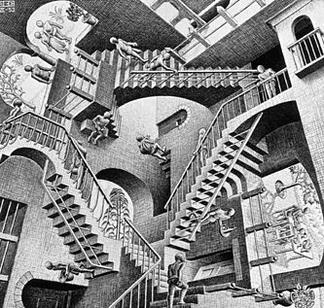
“There’s no sanctuary when everyone around you is insane!”
From gleam to rust, ‘Mekkanikk’’s Forbidden Planet synthesizer bleeps and bloops introduce a slow robotic swing, framed with oil can percussion. There’s a sense of the sensual, but it’s robotic, mechanic, ersatz sex in a cybernetic half-life. In his robotic afterlife Ka Spel’s character ponders: “Will you respect me in the morning?” Love was lost some time ago and bodies are now rusting.
“She is so beautiful tonight.”
Hallway of the Gods flits from the more electronic songs to the more acoustic/rock tracks throughout its duration, and with ‘Sterre’ (old Dutch for star) we now get the first of the latter. Incorporating strumming and slide guitar, acoustic drums and wind instruments, ‘Sterre’ wanders alone, a female figure lost in the woods, while elsewhere, somewhere, an evening campfire crackles, emotional embers glow… and then fade.
“We’re trapped here till we die! Die! Die!”
‘Spike’ – With a lurch the mood has changed, we’ve upped a gear and we’re grooving down the autobahn, maybe not as shiny as once we were, maybe a little dented round the edges, but this old tour bus can still move and shake. Sequenced crunching synths and beats meet seemingly stream of conscious lyrics, and after the preceding songs of stunned or numbed reflection we have takeoff! But we’ll soon discover things might not always be what we hoped for…
“Should I stand here like a sheep and dye a target on the space between my eyes?”
‘All Sides’ – Now THIS sounds like the Pink Dots, or the Pink Dots sounding like a memory of themselves? Hosting their own ghost, industrial grade rust permeates the limbs of this particular robotic rock track. It’s a slow motion mosh pit head banger drugged rush to weirdness. Spiked? Very likely. And it’s coming at you from all sides.
“Take us as we are”.
‘Harvest Babies’ – A nocturnal harvest corn dolly/corn baby, sacrificial offering with a funky somehow continental feel. There’s little to say, the music plays, the guitar solos: take it or leave it. The music is naked of particularly deep purpose but that is the point. It simply is.
“Dance with me….”
With ‘Lucifer Landed’ we have more acoustic guitar and college circuit Ameri-rock format Dots with synthi-shimmerings round the edges. Informed by ‘60s pop, this is the most Robyn Hitchcock the Dots possibly ever got. And after several songs about working through emotional fallout, there’s a sense of something approaching hope, a reawakening or new beginning? “Don’t you feel mysterious today?” asks Ka-Spel, kind of wearily. Tangentially I’m reminded of Wire. The tone of this track suggests the main protagonist is now older, wiser, wounded and slightly more cautious perhaps… but mysterious? With a semi defeated grin the reply returns: Possibly.
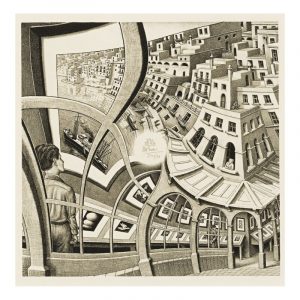
“You offer me no sympathy.”
‘The Hanged Man’ – Psychedelicious. This is the Pink Dots at their Satanic Majesties Request best…like a slowed down, trippier take on the Rolling Stones’ ‘Citadel’ it swaggers in purple velvet, a narcotic never ending nightmare “Get me out of here” cries Ka-Spel, his brain on fire as the party swims on around him. Sometimes there’s a price to pay for freedom or fame and the question asked is: was it worth it?
“There is no moon tonight, but the stars are whispering our names.”
‘The Saucers Are Coming’ – From its spoken word intro to its conclusion at 11.14, ‘Saucers’ is an EPIC in the Dots canon. I could write until the kidnapped cows come home (probed or in pieces) about this story of alien invasion, about how reportage, rock, and collage collide inside its sci-fi krautrock mainframe resulting in pounding Can-like grooves, proving anti-gravity devices do exist after all. From this track onwards to the album’s conclusion there’s a sense that the Dots are fully immersed in the present, breathing in the moment, rather than looking backwards or coming to terms with what is no more.
“Your face seems so familiar, perhaps we’ve met some place before.”
‘Destined to Repeat’ – An initial impression is that this is familiar, even the metre reminds me of previous Dots tracks,
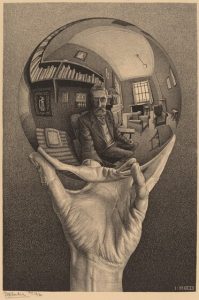
which is possibly the point. It’s another low-key number acting like a come down track after the excitement of ‘Saucers’. In this track the previous themes of broken relationships and the pressures and travails of the travelling band merge and coagulate into an acceptance that: this is all there is…they’re destined to repeat. It’s all they can ever do. Or need to do. Driftwood on an endless sea. So Pink Floyd.
“In the passage, with the mist up to my knees, a frightened savage.”
‘Hallway’ – Finally, here we are, in the Hallway. A monumental track that deals with acceptance of the challenges of a life in art, the price of fame or the cost of obscurity, and all that comes with either. It’s a dream sequence, and dependent on your personal religion it’s the equivalent of a meeting with St Peter at the Pearly Gates, a Viking trip to Valhalla, or that moment of final fossilization in the aforementioned Rock and Roll Hall of Fame.
The Dots have reached their own personal ‘Heart of Darkness’ and Ka-Spel’s final words are….“It’s too horrible”.
Essential.

‘On High’ also makes it clear that this is to be a headphones album. Like Björk’s Vespertine (2001) you only get the intimacy of the music’s spatial dynamics if there the stereophonic experience is right there in your earholes [‘Headphones’ is, unsurprisingly, a particular highlight in this regard – I remember sitting on a bus in Ipswich and the song came on and it felt like my head had been transformed into a hydraulic machine, steam issuing from my ears]. Having the music right there in your ears also means that it comes as an intimate shock when, at the end of the track, the music fades out and Edward drops his speaking voice from the cry of “There’s no sanctuary… ” to the plain-spoken “… when everyone around you is insane”. This registers with chilling, comforting recognition when listening in the wake of the tragic (though predictable) failure of the Cop26 climate talks in Glasgow. Coal will be phased down rather than phased out. No reparations will be paid low-lying island countries and those in the Global South (Haiti; Yemen; Kiribati, etc.) despite having contributed the least and suffered the most already from climate change. Limiting global warming to 1.5 degrees Celsius is becoming an increasingly delusional fiction; a pipe-dream, despite its necessity in the struggle to maintain a habitable Earth.

Hallway of the Gods is a rich and varied album. While John makes a convincing case for its thematic synthesis, musically it can move quite dramatically between tracks. The next track, ‘Sterre’, is an electric-acoustic weepy. While it was the single from the album, it sounds quite different to anything else here, only sharing some tonal DNA with later track ‘The Hanged Man’, a strange and wistful ballad in its own right. ‘Sterre’ is a lovely, warm, empathetic track, apparently sharing a name with Edwin Van Wanrooij’s daughter. Edwin played guitar for the Dots during this period and lends the band an almost Cat Stevens/ Eric Clapton sound that should have massively broadened their commercial appeal. While I do not believe that Edward has ever written and sung any lyrics completely in Nederlands [though please correct me if I am wrong!] it is nice to see more Dutch words entering the band’s lexicon around this period, with ‘Sterre’ being Nederlands for ‘Star’.

‘Sterre’ is very much a song you can imagine the lighters (or mobile phones) coming out for at a gig; ‘Spike’, meanwhile, is a club song through and through. It could even be mistaken for a forgotten single from the Smashing Pumpkins’ somewhat neglected Adore (1997), the sound of industrial psychosis and cultivated despair. I’ve been fortunate enough not to lose any of my best friends to heroin, but I’ve/they’ve been frighteningly close. This song captures the mix of heavy emotions in that experience. The despair of the following track, ‘All Sides’, is more cosmic in nature, even recalling the poppier tracks of Cardiacs’ Guns (1999), especially the weird and rapturous single ‘Signs‘. ‘All Sides’ is a bit more ominous and churning – the autocratic oppressions of The Tower have been replaced by a more metaphysical threat – signalled by the funereal organs, woozy synths and horrible industrial cycles of noise that eclipse the ending of the track. Ka-Spel’s desperate and terrified narrator asks aloud, “Should I mumble words to she who sees me naked from all sides? Is it all a little late to start believing? Oh I believe all sides… Oh anything…”, willing to save his skin through invocation and devotion to whatever entity terrorises him, whether She be Kali or Kassogtha.
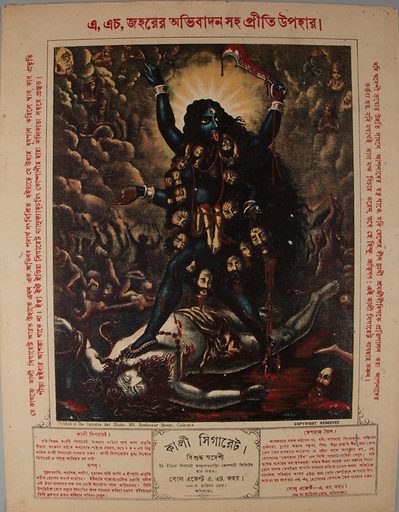
The linked article on Kali by Annalisa Merelli refers to the Hindi Goddess as embodying “the boundless and existential freedom to be—without seeking permission”. Ka-Spel, in the tradition of Theistic Satanism, pursues this freedom across HotG (and arguably across all of the Dots’ mid-period canon) but is also frightened by the implications of this freedom, his narrators often too neurotic or self-doubting to fully commit to it.
The album’s next three tracks, ‘Harvest Babies’, ‘Lucifer Landed’ and ‘The Hanged Man’ are a fuzzy triptych of 1960s psychiadelica, representing perhaps the first time that the Dots have worked in a recognisably nostalgic mode. The tracks run the risk of becoming new age adult contemporary, but their lyrics are anxious and elusive enough to avoid this. ‘Harvest Babies’ is faintly syncopated, soothing yet seasick. ‘Lucifer Landed’, an unusually steaightforward acoustic guitar strummer, comes at exactly the right point on the album. Edward’s vocals are lovely and lilting and only a trifle sardonic. Ryan Moore’s folksy playing really comes into its own here. Finally, ‘The Hanged Man’ is a real snazzy throwback, the production as wholly convincing as The Dukes of Stratosphear’s to produce much the same sound on 25 O’Clock (1985) and Psonic Psunspot (1987).
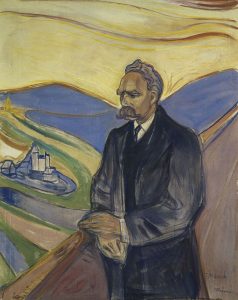
‘The Saucers are Coming’ develops from a spoken word piece into a 1950s sci-fi freakout. Unlike Tom, I marginally prefer the version on Chemical Playschool 10 (1997), the next album for us to review, so I will discuss the track in greater depth there. ‘Destined to Repeat’ is a gorgeous gloaming headphones track, an intimate epic that takes a Romantic look at Nietzsche’s concept of the Eternal Return. The track is very much of-a-piece with the folksier stylings of From Here You’ll Watch the World Go By (1995) but even more musically developed. A sublime melody that shifts uncannily into ‘Hallway of the Gods’ itself, a ritual from some distant dark place that summons a howling abyss. Taken together the tracks are enough to remind you that the Dots are one of the most essential banks of this or any era.
In our review of 9 Lives to Wonder (1994) I described ‘9 Shades to the Circle’ as “three synthesizers steam[ing] in Hell until chuntering bass and trippy drums bring you down to Earth”. The exclusive vinyl bonus side for the HotG was a live version of ‘9 Shades’ recorded in Houston, Texas. This makes sense since ‘9 Shades’ is the kind of jamming psychedelic freakout that the Dots turned to again on HotG with ‘The Saucers are Coming’. The crowd are wild and rapturous, eager to be beamed up. The music thrums and circles at first, languid. The guitar is lazily seductive and the hi-hat insinuating. The track builds slowly like a piece of weird fiction by Robert Aickman. It is a sinister yet comic tale of demonic invocation that peaks halfway in a cacophony of terror, with heavier, doomier guitar than you might expect from the Dots. The second part of the track is more ambient and progressive, with some pleasingly sinister John Carpenteresque synths. Ka-Spel’s vocals reach a hysterical pitch, but they seem more performative than authentically unhinged to my ears in this case.
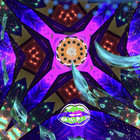
The official Bandcamp page for the album also includes the songs from the ‘Sterre’ single release. ‘Spike (psychomix)’ grinds away a little harder than the original to teeth-gritting (though maybe not fist pumping!) ends. It is also – curiously – rather more funky, with the electric guitar (feedback and all) really soaring at the end. ‘The Elephants’ Graveyard’ is a bit of a curio and I think it was the correct decision to leave it off the album proper. It has a strange, seductive groove to it, but it noodles about without much direction. One I need to take me with on a nighttime walk I think… van Hoorn’s horns really do sound like elephants though! Finally, the instrumental mix of ‘Sterre’ is just as lovely as the original song and might help teach the musically-inclined listener how to play along on acoustic guitar.
Overall, a terrific, far-sighted, sometimes overwhelming album that rewards patient listening to sink fully into your bones.
